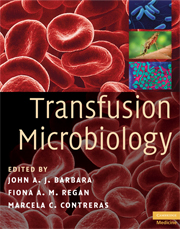Introduction: Transfusion-transmitted infections, then and now
Published online by Cambridge University Press: 12 January 2010
Summary
In 1983, a small textbook was published entitled Microbiology in Blood Transfusion (Barbara, 1983).
At the beginning of this book the characteristics of microbial agents that might predispose them to the potential for transmission by transfusion were explored. Some of the characteristics identified included:
Presence of the agent in one or more of the constituent components of blood
Propensity for causing asymptomatic (sub-acute) infections
Protracted incubation period to the development of symptoms
A long-term carrier state of expressed microbial components (e.g. HBsAg in the case of hepatitis B virus)
A long-term latency of the agent via incorporation of the microbial nucleic acid into the white cells of the infected host. The microbial nucleic acid could reactivate to initiate infection in the recipient of a transfusion from an infected donor.
In any table of transfusion-transmissible infections (TTIs) summarizing the situation at that time, the predominant microbial agents featured would typically be persistent rather than acute. More recently, the risk (actual or potential) from acute infections, especially in situations of high incidence and attack rates in a population, has also become a significant issue. The epidemic of West Nile fever virus (WNV, see Chapters 6 and 15) is a very good example of this. A summary of the currently clinically significant TTIs is shown in Table 1. These agents will all be covered in detail throughout the ensuing chapters. Chapter 6 also considers the potential risks from ‘new’ or newly recognized agents.
- Type
- Chapter
- Information
- Transfusion Microbiology , pp. 1 - 8Publisher: Cambridge University PressPrint publication year: 2008
References
- 1
- Cited by

